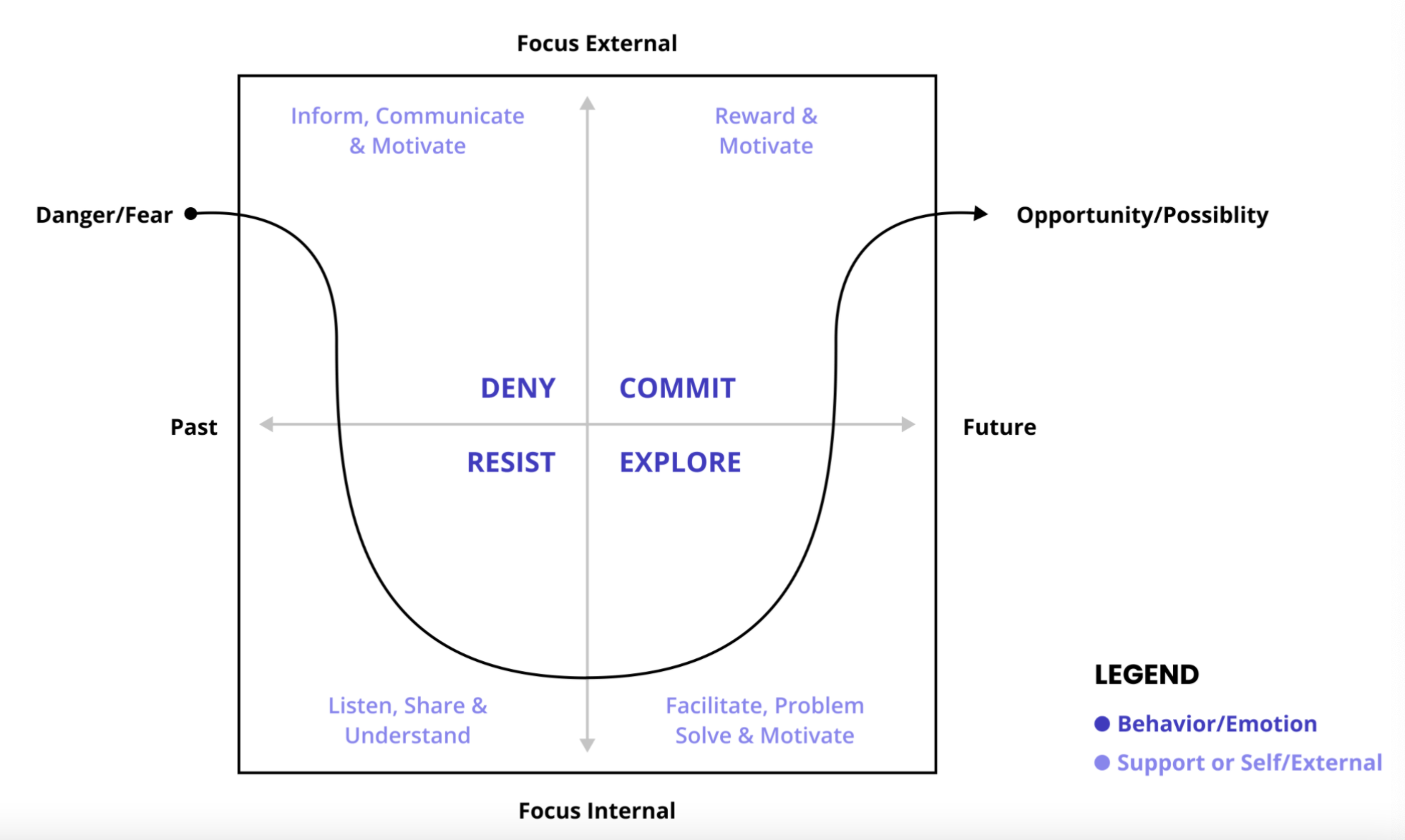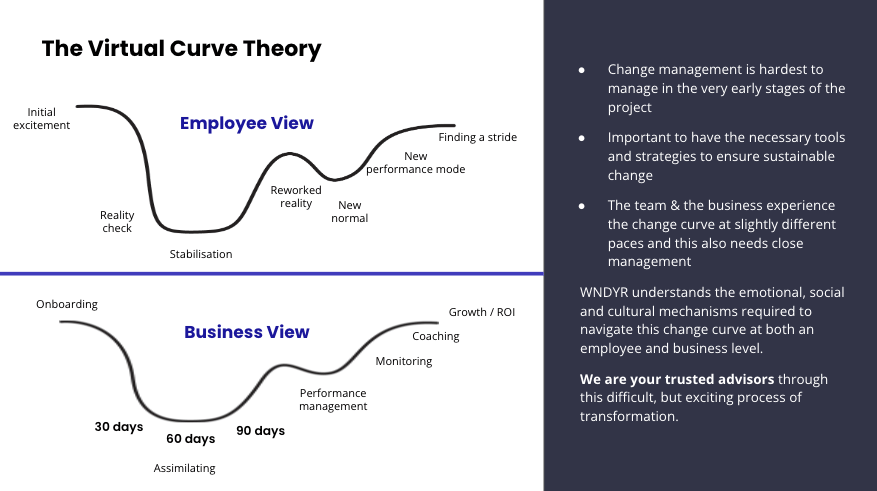If digital transformations were just about new technology, they'd be simple. Just subscribe to the "right" project management platform, maybe feed your most boring tasks through the hottest new Artificial Intelligence bot, and boom! Digital transformation accomplished. Your company will remain competitive forever. What's for lunch?
Alas, it's more complicated than that, because successful digital transformation requires the most complicated "tech" of all: human beings. The fact is, any worthwhile digital transformation strategy is also a change management strategy. Countless flashy, cutting-edge, big-bucks digital transformation efforts have failed because change management wasn't given its due attention.
So how can you keep your organization out of the graveyard of doomed digital transformation projects? How can you be sure that the expensive apps and shiny new technologies and efficient new processes actually get used by the humans who do the work? By understanding change management: how people experience change and the pitfalls and opportunities at each stage of the process.
Why do humans resist change? It's a brain thing
We're creatures of habit. Deep in our brains, structures called the basal ganglia create the automatic neural pathways that "wire" unconscious habits into our brains. That's why we don't have to think about putting one foot in front of the other when we walk, how to lift a fork to our mouths, how to sign our name, etc.
Another cluster of cells near the base of the brain, the amygdala, waits for our senses to pick up on potentially threatening changes in our surroundings. When danger is near, the amygdala floods our bodies with stress hormones. This overwhelms the parts of our brain where calmer, more rational thinking happens, so we can focus all of our attention on fighting or fleeing.
Both of these processes were crucial to our species developing complex abilities and surviving a wild world. But they can hinder our decision-making in less immediately perilous situations. A successful change management strategy will take into account those deep tracks laid down by the basal ganglia, and the amygdala's tendency to treat every benign change like a sabretoothed tiger skulking around our campfire.
Deny, Resist, Explore, Commit: the Scott & Jaffe Model of Change Management
The most influential way to understand how humans respond to organizational change was originally proposed by academics Cynthia Scott and Dennis Jaffe. You've probably heard of the "stages of grief" first described by Elisabeth Kübler-Ross. Similarly, the Scott and Jaffe model treats change as a kind of grief, as well as a perceived threat. Notice how the journey starts on the left with "Danger/Fear".

No two people or groups will necessarily follow the stages in the same order. Some may skip some stages altogether. But the general progression through each quadrant tends to be:
- Deny: We try to pretend it's business as usual. We don't feel the impact of the change acutely yet.
- Resistance: We realize the change is really happening. Feeling anxious, threatened, and angry, we take action to thwart it. Change resistance can take both conscious (arguing, quitting) and unconscious (illness, distraction) forms.
- Exploration: We start to understand that the change is inevitable, so we look for ways to accommodate it. This is when the benefits of the change begin to become more apparent.
- Commitment: We accept the change and start to look past it into the future.
While the scope of digital transformation initiatives may vary, an effective change management strategy recognizes that human beings are fundamentally similar. To manage change is engage with the emotions of the humans undergoing that change. That's true across cultures, industries, and business models.
Bringing the change curve into digital transformation
So what does that model of change look like, specifically, when applied to digital transformation? WNDYR's experience in change management for hundreds of thousands of employees worldwide has helped us build an understanding of how both the team and the business experience change.

As you see, while the two curves are roughly similar, the peaks and valleys of change tend to be sharper for individuals than the business as a whole. These phases don't necessarily correspond in time, either. The experience of organizational change is inherently somewhat subjective, since roles, impacts, experiences, and personalities vary widely across the company.
To lay the groundwork for a successful digital transformation, an organizational readiness assessment will look at the organization's culture to determine how socially and psychologically prepared the company is for change. The leadership team sets the tone here. A company with a culture of risk aversion and a punitive approach to dissent, for example, will likely struggle more to implement change than one that encourages autonomy and active participation.
The initial excitement of the honeymoon phase
Most organizations don't opt for digital transformation just because it seems like a good idea. It's because the shortcomings of their existing processes and technology are causing problems they can't ignore. So when a digital transformation is first proposed and begins to be implemented, the vision of a workplace without those problems is exciting.
The company's communication channels may be abuzz with ideas and discussion. The powerful potential of new technologies will be more obvious than the bumpy road it will take to get there. The danger, of course, is that when that promise isn't immediately fulfilled, disappointed employees will turn against the entire project. So managing expectations is important to sustaining this excitement through the next, harder phase.
Here comes the reality check
Change is uncertainty. The early stages of digital transformation are the most difficult and precarious. As "the devil you know" is replaced by the unknown, as day-to-day work life gets more unpredictable, as mistakes and inefficiencies pile up, the urge to minimize disruption and mitigate errors will be powerful. This is where most digital change initatives fail.
Remember the basal ganglia? It's starting to realize that it's going to have to do the hard work of building new pathways. And the amygdala? Now it's seeing tigers behind every tree. Employee resistance, both overt and subtle, is on the rise. The most pessimistic voices seem to have a point: if this is what digital transformation is, maybe the existing business processes weren't so bad.
Change management strategies must be ready for this disillusion. Unified leadership, setting the example of embracing change, can go a long way toward keeping everyone focused on the benefits of digital transformation. It's up to leaders to walk a fine line between making clear that user adoption is not optional, and giving people room to grieve the familiar ways of working that they've lost.
Stabilization & assimilation: take a deep breath
If the c-suite can hold its nerve, employees' moods will begin to stabilize as the change is assimilated deeper into the organization's practices. The basal ganglia will start creating new automatic pathways. The amygdala will see that the new technology isn't a monster. A successful digital transformation is still a ways away, but this is the moment of calm that makes it possible.
Among the key stakeholders, project managers are often most crucial at this stage of change management. If you can get them on the same page as to the benefits of digital transformation, they can be powerful advocates. It's also essential to keep lines of two-way communication open, so employees can contribute to the change and feel some ownership of it.
The reworked reality and the new normal
Eventually, maybe 90 days into the digital transformation process, the bugs will be mostly worked out. The new business processes and digital technologies won't be so new anymore. Change management will be less about implementing new practices and more about sustaining those practices. This corresponds to the the "Exploration" phase of the Scott and Jaffe curve.
Does this mean the change team's work is over? Not at all. Despite the relative calm, this is another key juncture that can make the difference between successful digital transformations and failed ones. The digital transformation must now deliver on its promises.
The new normal must be better, easier, more efficient than the old normal. The gain in competitive advantage must be clear. If not, the leadership team runs the risk of losing the trust of not only those who were skeptical all along, but those who sincerely wanted to embrace change and now feel disappointed. Performance management should focus on four major directions:
- Facilitate the maximum benefit of the new tools and processes.
- Problem solve to remove barriers to performance gains.
- Incentivize the preferred best practices in the new system.
- Publish wins to the entire org with a solid communication plan.
Coaching and monitoring in the new performance mode
It's likely that through the digital transformation process, individual KPIs have been all over the place. Indeed, that's probably one of the major sources of anxiety for employees. Once the new normal has been established, successful change management hinges on clarifying and optimizing those new performance standards.
This naturally requires close monitoring, to see who is adapting well to the new processes and who needs help. It requires individual coaching to unlock the productivity benefits and reduced stress that digital transformation can bring to everyone.
As we said above, individual workers will experience this change at a different pace from each other, as well as from the business as a whole. This phase of your digital transformation is time to tend to those individuals who may have been left behind.
Hitting your stride and unlocking growth
So here you are. It hasn't always been easy. But by this phase of the digital transformation curve, the ROI is pushing into positive territory. Even more importantly, your organization is set up for ever-compounding gains in the future with your new business operations in place: less wasted time, fewer mistakes, less friction, much less burnout and turnover.
This is the vision you set out to achieve at the very beginning of this process. Change management, at this point, is about consolidating and optimizing the changes you've put in place. And, of course, looking for opportunities for further changes to unlock even greater benefits.
"The End" is never really the end
As long as the world keeps changing, so will your organization. Digital transformation is an ongoing process. The good news is, after a successful digital transformation project, your organization has learned how to change. You will have built the change management capability you'll need to ensure future changes will be easier, faster, less disruptive, and more valuable.
And the even better news is that you don't have to do any of it alone. WNDYR has made digital transformation a reality for organizations of all sizes, across industries and continents. Contact us today to find out how we can bring that vision to life for your employees, too.